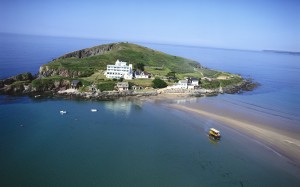Plans to install 200 solar panels on a privately-held island made famous by English author Agatha Christie have been put on hold after attracting huge criticism from the local community.
The private island which provided the inspiration for several of Agatha Christie’s murder mystery novels has found itself at the center of a veritable solar storm, after an application to transform 335 square meters of Burgh Island into renewable energy site sparked vociferous criticism across the local South Devon community.
Burgh Island, located approximately 270 yards from Bigbury-on-Sea in the English county of Devon, is home to just three buildings, including a stunning art deco hotel, formerly patronized by the likes of Noel Coward, The Beatles and prolific murder mystery writer, Agatha Christie, who wrote the critically acclaimed Hercule Poirot story, Evil Under the Sun (1982), during one of her frequent stays on the island.
Decades after Christie completed the aforementioned novel; Burgh Island once again finds itself at the center of another gripping case – this time involving 200 shiny solar panels. In early November 2014, the island’s owners, Tony Orchard and Deborah Clark, applied for permission to transform a 335 square meter patch of land (roughly the size of a tennis court) into a solar energy site, citing a desire to reduce both the island’s electricity bill and its carbon footprint.
Aware that their decision had the potential to create controversy, Orchard and Clark, who outbid the National Trust to secure the rights to the island in 2001, took great pains to incorporate the site into the natural surroundings, going as far as agreeing to hide the proposed plot behind a hedge in order to protect and preserve the island idyll. With the famous art-deco hotel reliant on oil, bottled gas and electricity from the mainland grid, it was clear something had to be done.
Yet whilst the principles behind the proposed switch to solar power must surely be admired, the practicalities of the decision have failed to inspire the local community – many of whom were nothing short of incensed by the prospect. One of the loudest critical voices was Burgh’s former owner, Tony Porter, who sold the island to its current owners after investing much time and money into returning the island’s famous art-deco hotel to its former splendor.
Convinced that the planned solar site will amount to little more than an eyesore, Porter told the Daily Mail that he was “horrified” to hear that an application had been lodged. “We spent 16 years doing everything we could to restore [the island] to its former beauty,” he explained. “Now this green island sleeping in the sun is going to be scarred by this horrible shiny thing. It will be visible from miles away. It’s going to glint in the sun and spoil the whole thing.”
More than 30 formal objections had been lodged within days of the application for permission going live, including from Mr. Porter and from a series of neighboring residents, who described the proposals as both a “monstrous carbuncle on an old friend” and “ruinous for the beauty of the island.” Warning that the construction of a solar panel site could ultimately discourage walkers from the island; one gentleman concluded that the move is not in the interests of protecting and maintaining an area of natural beauty.”
John Chalmers, of the South Hams Society, offered a contrasting view, encouraging critics to consider the proposals with a “practical, not emotive view,” explaining than whilst Burgh Island is a site of considerable significance, “the actual harm caused must be considered fairly minimal compared with other sites where you see a whole sea of panels.”
In the end though, the public misgivings were too much for the environmental intentions of Orchard-Clark and the planning permission fell at the first hurdle after being rejected in a unanimous parish council vote. Councillor Rose Owen summarized: “I agree with the need for sustainability and finding alternative methods of producing power, but it is an area of outstanding natural beauty and a historic island so it is totally inappropriate and out of place.”
The official investigation into the planning application was damning: “A change in the landscape character and a high visual impact on the surrounding environment within the Area of Outstanding Natural Beauty were cited as the most important ‘material considerations’ in reaching [a decision to turn down the application]. The development was therefore felt to be quite inappropriate.”
According to guidelines published in the National Planning Policy Framework, “developments within an Area of Outstanding Natural Beauty should only be permitted in exceptional circumstances and then only for the benefit for the public.” Orchard and Clark have since confirmed that they now intend to take their application to the South Hams District Council – the administrative authority responsible for Burgh Island – for further consideration.
Private Island News received the following response after contacting the South Hams District Council: “[The planning permission application] presents a unique situation, in so far as Burgh is a private island and yet planning is a public process.” A council spokesman added, “This type of planning application had not been put forward for the island before, but every application is looked at individually on its merits.”



